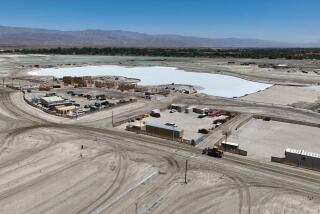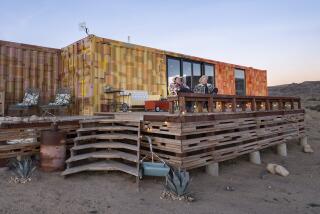A new generation of Desert Modern
PALM SPRINGS â Taylor Souriall said she felt immediately drawn to the architecture of the 48 Arenas condominium complex when she first saw the drawings two years ago. The cluster of two-story, square-shouldered buildings was clean and hard-edged, painted in desert colors: dusty red, greenish clay and pale yellow. Tough-looking steel verandas and canopies cut sharp horizontal lines into the vertical mass of the buildings.
The Modernist design clinched the deal for Souriall, a retired flight attendant who grew up in Houston with the 1950s-era furniture of George Miller and Charles and Ray Eames. âI bought one sight unseenâ before construction began, she said of the two-bedroom, 2 1/2-bath unit, for which she paid $357,000.
Buyers like Souriall, smitten with Modernist architecture, are discovering a new generation of housing designed in the style that came of age in the Eisenhower and Kennedy eras. Three Modernist residential developments are currently under construction in the city and more are expected.
Midcentury architecture garnered national attention in 1998 with the restoration of the Kaufmann House here, a largely forgotten masterpiece of 20th century design by Richard Neutra. The house, built in 1946, was restored by the Los Angeles-based firm of Marmol Radziner Associates.
A splashy 1999 Vanity Fair spread on Palm Springs sent home buyers here in search of retro homes and Modernist diamonds in the rough.
Given the demand -- and steadily rising prices -- home builders have found plenty of buyers interested in the new versions. Home builder Dennis Cunningham, who developed 48 Arenas, is constructing another Modernist project here, 48 at Baristo, a cluster of townhomes, each with its own private pool and courtyard.
The pricing of the first phase is in the mid-$400,000-to-$500,000 range, and the second phase, which will start later this year, may be $100,000 higher in price per unit.
The renaissance of Modernist housing, which cognoscenti like to call Desert Modern, reflects several factors. The growing population of year-round residents has kept up the demand for new housing in a city that historically has been a winter resort. And many design-conscious buyers are seeking an alternative to the Spanish and Mediterranean homes blanketing much of Southern California.
Thereâs a smattering of all styles here, but midcentury Modernism prevails. In the 1930s and â40s, Palm Springs attracted European-trained architects, including the Austrian-born Neutra and the Swiss-born Albert Frey. The sparsely developed desert landscape was an ideal foil for their philosophy of an architecture that not only could coexist with nature, but would be completed and perfected by it. Their rationale: Glass-walled structures appear almost delicate against the rugged background of scruffy desert and looming mountains.
Soon, a younger generation of largely American-born and -trained architects, including William Cody, Stewart Williamson and Donald Wexler, helped make Desert Modern of the 1950s into a style that was, at the same time, cosmopolitan and regional, casual and elegant, functional and hedonistic.
New design was not limited to fastidious architects, however. Seizing on the image of up-to-date modernity, tract builders tossed up thousands of handsome, inexpensively built houses in a commercial version of the Modernist style. The best known are those built by the Alexander Building Co., which produced about 2,500 houses in the late 1950s and early â60s, many designed by the Los Angeles firm of Palmer & Krisel.
Jack Meiselman, a builder and onetime collaborator of Alexander, built hundreds more on a different floor plan. Intended as vacation houses during the temperate winter months, these houses often sold for less than $20,000 -- a starter price in the late 1950s and early â60s.
Nowadays, the Alexander and Meiselman homes are selling for $300,000 to $400,000 to new buyers, who must often spend $100,000 or more rehabbing the houses to present-day standards, according to Robert Ramblas, a real estate sales agent with Re/Max Real Estate Consultants in Palm Springs.
In fact, the desire not to rehab was a selling point for Randy Clarke, another buyer at 48 Arenas. A retired controller for a Bay Area construction company, Clarke said he was looking for âsomething I didnât have to refurbish.â He bought a loft-style unit with two levels and three bathrooms for $387,000 -- a price considered affordable for rapidly appreciating Modernist homes here.
If the new projects echo the Modernist housing of earlier decades, the new Desert Modern houses are not cookie-cutter copies of the 1950s prototypes. In some important ways, in fact, the new houses are quite different in form and philosophy from the originals.
Desert Modern houses featured deep overhangs on roofs to provide shade from the harsh sun, while sliding glass doors emphasized the idea of living indoors and outdoors simultaneously and of maximizing sunlight and breezes during the mild winter months. Most houses lacked heating and air conditioning until the 1950s, according to Peter Moruzzi, founder of the Palm Springs Modern Committee, a preservation group.
Not surprisingly, the new houses take advantage of newer building technology, especially mechanical heating and cooling. Wall insulation and double-pane glass lock out the triple-digit heat of spring and summer. Those features are especially important for year-round residents.
An even greater contrast, the new Desert Modern housing is high-density and urban, unlike the suburban Alexander tracts. Nearly all the older housing is single-story and low-lying, emphasizing the horizontal. The new is multistory and has strong vertical lines. And unlike the Alexander tract homes, which were built on virgin land, the new projects are on tight infill sites inside a mature city.
Much of the new look has to do with the high cost of land and construction, according to Jay Reynolds, a Los Angeles architect who is a partner in a home-building company called Symphony Development.
âWe canât be as cavalier as earlier developers that had one-acre plots and put these wonderful houses on them,â he said. âGiven the land economics, you have to fit so many pieces on the land.â
At the same time, certain Modernist values survive, such as the idea of bringing the landscape into the building. âItâs the sunlight, the air and the view,â Reynolds said, adding, âThe view is what is really important. Everybody wants to bring that mountain into their house.â
Cunningham is credited with starting the wave of new Modernist construction with 48 Arenas and 48 at Baristo, with Designarc of Los Angeles as architect on both projects. One competitor who gives Cunningham his due is Reynolds. âBecause of what he is doing, we could get investors,â Reynolds said. âIt opens up the bankerâs mind to the fact that you donât have to do Spanish-style housing in order to sell it.â
Reynolds, who has designed new Modernist projects here and in Palm Desert, started Symphony with two Los Angeles-based investors. They are set to start construction in May on 37 units -- a mix of detached townhouses, condominium buildings and a single-family home on a wedge-shaped lot. More than 100 buyers have expressed interest, according to Reynolds. Although the units have not yet been priced, Reynolds thinks they will start âin the $400,000s.â
He designed his first desert project last year: an uncompromisingly Modernist house for his mother and stepfather on a suburban hillside of Palm Desert. The austere facade of stucco and natural stone bears some resemblance to masterworks by Neutra and Frey, while having its own distinct style.
For homeowners, there are other things here that are beautiful besides the architecture. Just as the original midcentury homes have appreciated significantly, so have the new generation of Modernist homes.
Despite her love of the style, Souriall recently decided to move back to San Diego. âI miss the water,â she said. After living in her unit for only a year, she sold it at a $100,000 profit. If that level of appreciation is unremarkable for a fast-growing market like San Diego, she said, âitâs pretty good for Palm Springs.â
Morris Newman can be reached by e-mail at morris_newman@
sbcglobal.net.


